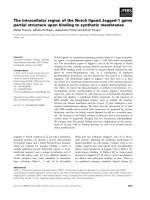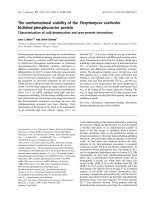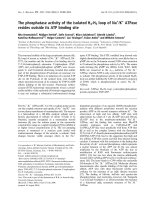báo cáo khoa học: "The recent introduction of a 1/29 chromosome translocation in South African Brahman cattle" pdf
Bạn đang xem bản rút gọn của tài liệu. Xem và tải ngay bản đầy đủ của tài liệu tại đây (612.09 KB, 8 trang )
Note
The
recent
introduction
of
a
1/29
chromosome
translocation
in
South
African
Brahman
cattle
N.D. NEL
E.J. HARRIS,
J.E.
WEIERMANS
E.H.H.
MEYER
Animal
and
Dairy
Science
Research
Institute,
Private
Bag
X2,
Irene,
1675,
Republic
of
South
Africa
Summary
A
1/29
chromosome
translocation
was
found
in
a
Brahman
bull
in
artificial
insemination
service.
In
the
subsequent
investigation,
it
was
established
that
most
of
the
semen
produced
had
been
sold
to
commercial
breeders.
An
extended
pedigree
showed
that
the
translocation
was
introduced
into
South
Africa
by
cattle
imported
from
the
USA.
The
anomaly
was
absent
in
a
random
sample
of unrelated
Brahman
cattle.
Key
words :
cattfe,
Brahman,
chromosome
abnormality,
translocation.
Résumé
L’introduction
récente
d’une
translocation
chromosomique
1 /29
chez
des
bovins
Brahman
d’Afrique
du
Sud
Une
translocation
chromosomique
1/29
a
été
détectée
chez
un
Brahman
d’insémination
artificielle.
Des
recherches
ultérieures
ont
établi
que
sa
semence
avait
été,
pour
la
plus
grande
part,
vendue
à
des
élevages
commerciaux.
Une
recherche
généalogique
a
montré
que
la
transloca-
tion
avait
été
introduite
en
Afrique
du
Sud
à
l’occasion
d’une
importation
de
bovins
en
provenance
des
Etats-Unis
d’Amérique.
L’anomalie
n’a
pas
été
retrouvée
dans
un
échantillon
aléatoire
de
bovins
Brahman
non
apparentés.
Mots
clés :
bovin,
Brahman,
anomalie
chromosomique,
translocation.
I.
Introduction
During
routine
cytogenetic
screening,
a
Brahman
bull
from
the
Artificial
Insemina-
tion
(AI)
Co-operative
was
found
to
be
a
1/29
heterozygote
translocation
carrier.
At
that
time,
this
three
year
old
bull
had been
in
service
for
approximately
18
months,
and
14 000
doses
of
frozen
semen
had
already
been
sold.
The
distribution
was
widespread
as
the
Co-operative
is
the
sole
commercial
supplier
of
cattle
semen
in
South
Africa.
In
view
of
the
importance
of
this
anomaly
in
world
cattle
production
(G
USTAVSSON
,
1969
&
1979 ;
P
OPESCU
,
1977),
the
discovery
of
this
bull
in
AI
service
was
seen
in
a
very
serious
light.
In
conjunction
with
the
Brahman
Cattle
Breeder’s
Society
of
South
Africa,
it
was
decided
to
trace
the
origin
and
spread
in
South
African
Brahman
cattle
and
to
investigate
the
possible
effect
of
the
translocation
on
fertility
and
growth.
II.
Materials
and
methods
Information
supplied
by
the
Breeder’s
Society
and
the
Al
Co-operative
was
used
to
locate
the
progeny
produced
from
the
sale
of
affected
semen
and
to
draw
up
an
extended
pedigree.
As
the
sire
and
grandsire
had
died,
it
was
necessary
to
screen
the
progeny
of
these
bulls
in
order
to
establish
the
inheritance
of
the
translocation.
Peripheral
blood
specimens
were
taken
from
227
possible
progeny
in
12
commercial
herds
from
different
parts
of the
country.
Under
extensive
ranching
conditions
it
is
not
always
possible
to
distinguish
between
calves
from
different
bulls.
A
further
14
related
cattle
(three
herds)
were
tested
together
with
a
random
sample
of
190
unrelated
Brahman
cattle.
The
latter
group
was
studied
in
order
to
investigate
the
incidence
of
the
translocation
in
the
general
population.
Giemsa
stained
metaphase
spreads
were
obtained
from
whole
blood
lymphocyte
cultures
using
a
method
adapted
from
that
of
M
OORHEAD
et
al.
(1960).
In
this
method,
concanavaline
A
(0.01 mg/ml)
was
used
instead
of
phytohaemagglutinin.
An
R-banding
method,
based
on
the
techniques
used
by
PorESCU et
al.
(1982)
and
Di
B
ERARDINO
&
InrrNUZZ!
(1982)
was
used
to
identify
the
chromosome
abnormality.
In
this
method
the
length
of
5’-Brdu
incorporation
was
reduced
to
five
hours.
The
study
of
growth
required
an
adequate
sample
of
normal
and
translocation
half-
sibs
under
standardized
conditions of
age
and
feeding ;
sibs
were
necessary
to
eliminate
a
sire
effect
in
the
analysis.
The
animals
selected
were
subjected
to
an
analysis
of
variance
(normal
versus
translocation
half-sibs).
A
sample
of
85
normal
and
121
translocation
records
from
one
farm
was
available
for
analysis.
The
weaning
(205
days)
and
post
weaning
indices
of
12,
18
and
24
months
were
used
in
the
computation.
The
index
is
computed
as
follows :
Index
(x) =
(ADG/ADG
of
the
group)
x
100
where
ADG
=
(mass —
birth
mass)/age
in
days
III.
Results
The
Giemsa-stained
and
R-banded
spreads
confirmed
the
presence
of
a
1/29
chromosome
translocation
(fig.
1
A
+
B).
The
presence
of
the
anomaly
was
confirmed
in
78
offspring
and
other
family
members
found
on
15
farms.
The
random
sample
from
the
general
Brahman
population
revealed
a
total
absence
of
any
translocation
carriers
(table
1).
origin
of
this
1/29
chromosome
translocation
was
tentatively
traced
to
the
great-grand
dam
(4)
of
the
affected
AI
bull
(1)
(see
fig.
2
for
an
extended
pedigree).
The
results
of
the
analysis
of
variance,
comparing
the
growth
rates
of
normal
and
translocation
sibs,
are
contained
in
table
2.
Although
the
translocation
cattle
show
higher
mass
indices
(0.5
to
4.4
%),
these
differences
are
not
statistically
significant
(P
<
0.05).
IV.
Discussion
and
conclusion
The
large
number
of
chromosomes
(relative
to
humans,
pigs
and
sheep),
the
morphology
of the
autosomes
and
the
inconsistent
results
obtained
with
banding
techniques
makes
the
identification
of
cattle
chromosomes
very
difficult.
Notwithstan-
ding
this,
the
examination
of
1
600
giemsa
stained
and
50
R-banded
affected
metaphase
spreads
confirms
the
presence
of
a
fusion
between
the
longest
and
shortest
chromosome
(1
and
29)
in
the
cattle
studied.
This
is
based
on
the
sizes
of
the
fused
chromosomes
in
the
case
of
giemsa
staining
and
on
a
consistent
match
between
the
chromosomes
studied
and
the
standard
karyotypes
published.
A
cow
(4),
thought
to
be
the
original
carrier,
produced
four
heifers
and
a
bull
calf,
all
of
which
are
dead
(fig.
2).
Unfortunately,
the
progeny
of
these
four
heifers
cannot
be
located.
The
translocation
was
however
traced,
via
his
progeny,
to
the
bull
calf
(3).
His
sire
(5)
when
screened,
was
found
to
be
normal.
It
is
thus
presumed
that
the
cow
(4),
the
great-grand-dam
of
the
AI
bull
under
investigation,
was
responsible
for
the
spread
of
the
translocation
in this
Brahman
family.
While
conducting
this
investigation,
evidence
to
support
this
conclusion
came
from
a
seemingly
unrelated
cow
(6),
identified
as
a
translocation
carrier.
The
extended
pedigree
showed
that
the
dam
lines
from
the
two
translocation
families
originated
from
the
same
stud
in
the
USA.
Heifers
from
this
stud
were
imported
in
the
early
1960’s.
The
records
show
that
most
of
the
14 000
doses
of
affected
semen
have
been
sold
to
commercial
cattle
breeders.
This
constitutes
little
if
any
threat
to
the
Brahman
stud
industry
in
South
Africa.
The
bull
(1)
has
subsequently
been
taken
out
of
AI
service.
The
few
animals
sold
for
stud
breeding
will
be
traced
where
possible
and
reported
to
the
Brahman
Breeder’s
Society.
The
identification
of
translocation
carriers
was
performed
with
the
express
purpose
of
showing
to
what
extent
the
anomaly
had
spread
through
the
sale
of
affected
semen.
The
78
identified
carriers
(table
1)
do
not
represent
an
incidence
as
it
is
difficult
to
identify
a
particular
bull’s
calves
under
extensive
commercial
farm
management.
The
inability
to
positively
identify
calves
would
also
account
for
the
discrepancy
between
the
expected
number
of
carriers
(113.5)
and
the
observed
number
of
78
carrier
cattle.
As
the
investigation
had
concentrated
on
only
one
Brahman
line,
it
was
deemed
advisable
to
study
the
incidence
of
the
anomaly
in
the
general
population.
As
shown
in
table
1,
no
translocation
carrying
animals
were
found
in
the
sample
studied.
It
is
thus
presumed
that
the
abnormality,
by
virtue
of
its
recent
introduction
to
the
country,
is
still
restricted
to
the
founder
line.
Althougtt
widely
distributed
throughout
the
world,
the
effect
of
the
translocation
is
still
a
point
of
conjecture.
There
are
strong
indications
that
the
fertility
of
carrier
animals
is
adversely
affected
(B
LAZAK
&
E!oRtocE,
1977 ;
G
USTAVSSON
,
1979 ;
KovAcs
&
C
SUKLY
,
1980 ;
R
EFSDAL
,
1976 ;
S
WARTZ
&
V
OGT
,
1983).
In
Southern
African
Brahman
cattle,
the
extensive
farming
conditions
and
the
lack
of
reliable
data
under
such
conditions
did
not
allow
for
meaningful
statistical
analysis
of
fertility.
In
the
absence
of
evidence
to
the
contrary,
it
is
necessary
to
accept
that
the
presence
of
the
translocation
causes
a
reduction
in
the
fertility
of
carrier
animals.
In
a
subsequent
study,
after
the
discovery
of
the
1/29
translocation
in
the
indigenous
Nguni
cattle
(NEL
et
al. ,
1985),
it
was
found
that
the
growth
rate
of
translocation
carriers
was
7 -
9 index
points
higher
(P
<
0.05)
than
that
of
normal
cattle
(unpublished
results).
As
an
increased
growth
rate
would
be
to
the
advantage
of
the
beef
industry,
it
was
decided
to
investigate
the
possible
effect
of
this
anomaly
in
Brahman
cattle.
The
results
in
table
2
show
no
significant
difference
in
the
growth
of
carrier
animals
compared
with
their
normal
half-sibs.
Although
not
statistically
suppor-
ted
by
the
present
data
there
is
a
tendency
towards
increased
growth
in
the
transloca-
tion
half-sibs.
It
would
be
worthwhile
repeating
this
investigation
using
an
increased
number
of
calves
born
in
different
herds,
seasons
and
environments.
Received
April
30,
1987.
Accepted
October
20,
1987.
Acknowledgements
We
thank
the
Brahman
Cattle
Breeder’s
Society
of
South
Africa
for
their
support.
We
would
also
like
to
thank
Taurus
Co-operative,
Dr.
P.E.
L
OMBARD
and
Mr
M.M.
S
CHOLTZ
for
their
contributions.
References
B
LAZAK
W.F.,
E
LDRIDGE
F.E.,
1977.
A
Robertsonian
translocation
and
its
effect
upon
fertility
in
Brown
Swiss
cattle.
J.
Dairy
Sci.,
60,
1133-1142.
Di
B
ERARDINO
D.,
InrrNUZZi
1.,
1982.
Detailed
description
of
R-banded
bovine
chromosomes.
J.
Hered. ,
73,
434-438.
G
USTAVSSON
1.,
1969.
Cytogenetics,
distribution
and
phenotypic
effect
of
a
translocation
in
Swedish
cattle.
Hereditas,
63,
68-169.
GusTnvssorr
1.,
1979.
Distribution
and
effects
of
the
1/29
Robertsonian
translocation
in
cattle.
J.
Dairy
Sci. ,
62,
825-835.
KovAcs
A.,
C
SUKLY
S.,
1980.
Effect
of
the
1/29
translocation
upon
fertility
in
Hungarian
Simmental
cattle.
Proc.
4th
Europ.
Colloq.
Cytogenet.
Domest.
Anim.,
Uppsala,
June
10-13,
1980,
35-43,
Swedish
University
of
Agricultural
Sciences,
Uppsala.
M
OORHEAD
P.S.,
N
OWELL
P.C
M
ELLMAN
W.J.,
BA
TT
IPS
D.N.,
H
UNGERFORD
D.A.,
1960.
Chromo-
some
preparations
of
leucocytes
cultured
from
human
peripheral
blood.
Exp.
Cell
Res.,
20,
613-615.
N
EL
N.D.,
HARRIS
E.J.,
W
EIERMANS
J.E.,
M
EYER
E.H.H.,
1985.
A
1/29
chromosome
translocation
in
Southern
African
Nguni
cattle.
The
identification,
occurrence
and
origin
of
the
transloca-
tion.
Génét.
Sel.
Evol.,
17,
293-302.
P
OPESCU
C.P.,
1977.
Les
anomalies
chromosomiques
des
bovins
(Bos
taurus
L.).
Etat
actuel
des
connaissances.
Ann.
Génét.
Sel.
Anim.,
9,
463-470.
P
OPESCU
C.P.,
R
ONNE
M.,
C
RIBIU
E.P.,
B
OSCHER
J.,
1982.
The
standardization
of
the
R-banded
karyotype
in
cattle
(Bos
taurus
L.).
Proc.
6th
Europ.
Colloq.
Cytogenet.
Domest.
Anim.,
Milano-Gargnano,
June
7-11,
1982,
172-190,
Edizione
curata
da
CLESAV,
Milano.
R
EFSDAL
A.0.,
1976.
Low
fertility
in
daughters
of
bulls
with
1/29
translocations.
Acta.
Vet.
Scand.,
17,
190-195.
S
WARTZ
H.A.,
V
OGT
D.W.,
1983.
Chromosome
abnormalities
as
a
cause
of
reproductive
ineffi-
ciency
in
heifers.
J.
Hered.,
74,
320-324.









